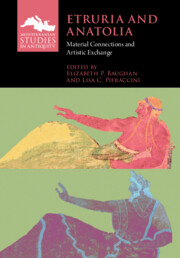Book contents
- Etruria and Anatolia
- Mediterranean Studies in Antiquity
- Etruria and Anatolia
- Copyright page
- Epigraph
- Contents
- Maps and Figures
- Contributors
- Preface
- Acknowledgments
- Notes on Abbreviations and Spelling
- Introduction
- Part I Broadening Perspectives
- Part II Interpretive Frameworks
- Part III Technology and Mobility
- Part IV Shared Practices
- Part V Shared and Distinct Iconographies
- Part VI Shared Forms, Distinct Functions
- 15 Forms and Functions of Beds and Couches in Etruscan and Anatolian Tombs
- 16 Female Assembly on Archaic Etruscan and Anatolian Funerary Monuments
- 17 Anatolian Fashion in Etruscan Clothing
- 18 Male Necklaces in the East and West
- Index
- References
16 - Female Assembly on Archaic Etruscan and Anatolian Funerary Monuments
from Part VI - Shared Forms, Distinct Functions
Published online by Cambridge University Press: 02 March 2023
- Etruria and Anatolia
- Mediterranean Studies in Antiquity
- Etruria and Anatolia
- Copyright page
- Epigraph
- Contents
- Maps and Figures
- Contributors
- Preface
- Acknowledgments
- Notes on Abbreviations and Spelling
- Introduction
- Part I Broadening Perspectives
- Part II Interpretive Frameworks
- Part III Technology and Mobility
- Part IV Shared Practices
- Part V Shared and Distinct Iconographies
- Part VI Shared Forms, Distinct Functions
- 15 Forms and Functions of Beds and Couches in Etruscan and Anatolian Tombs
- 16 Female Assembly on Archaic Etruscan and Anatolian Funerary Monuments
- 17 Anatolian Fashion in Etruscan Clothing
- 18 Male Necklaces in the East and West
- Index
- References
Summary
This paper examines the relationship between images of women on funerary monuments in Etruria and Anatolia, with particular focus on the so-called “female assembly scenes” on Chiusine cippi of the Late Archaic period. In these reliefs, groups of seated women drape and exchange textiles among each other. Although scholarly opinion differs on the meanings of these scenes, the visual focus on cloth as a component of social or religious ritual is paramount. The importance of the textile within the specific Etruscan context of these scenes is further emphasized when considered alongside contemporaneous reliefs in Anatolia associated with females, most notably those on the Polyxena sarcophagus from a tomb in the northern Troad. Through both visual analysis and attention to broader issues of gendered representation and identity, this chapter examines the importance of cultural context for interpreting female-focused narratives in both ancient Etruria and Anatolia.
- Type
- Chapter
- Information
- Etruria and AnatoliaMaterial Connections and Artistic Exchange, pp. 290 - 302Publisher: Cambridge University PressPrint publication year: 2023

